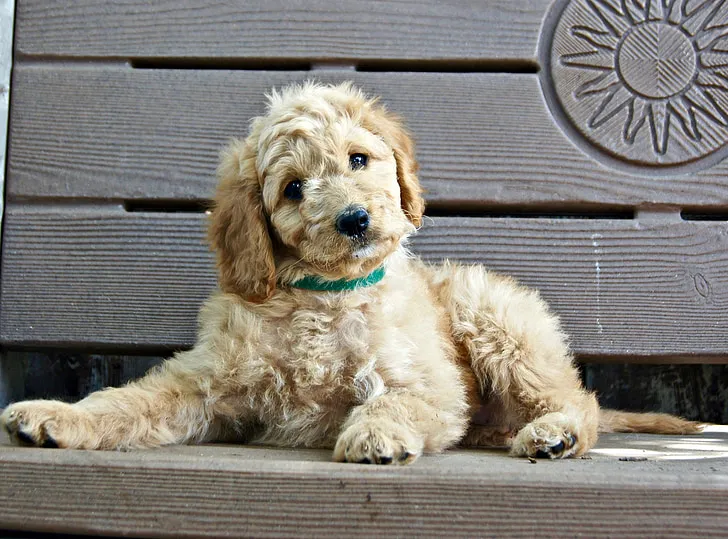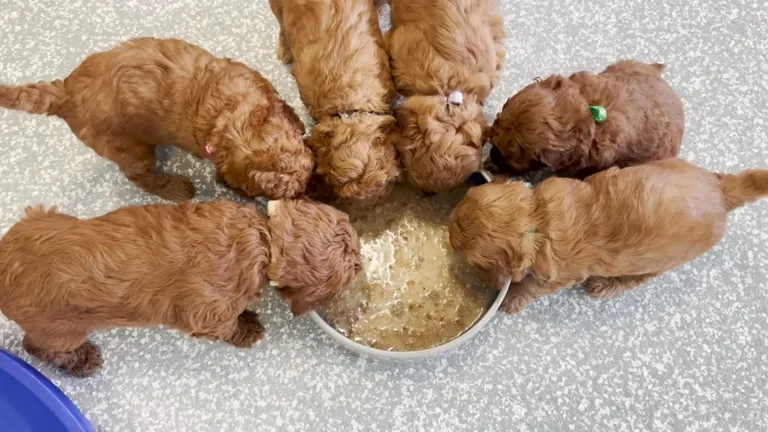5 Essential Mini Goldendoodle Training Methods in First Year
Before training a mini Goldendoodle, you should think about what type of dog you aspire to have as a companion. The answer to this question will decide your approach toward shaping the nature and behavior of your Goldendoodle.
There could be several concerns like high energy, prey drive, excessive jumping, housebreaking, etc. All of these unpromising events can be minimized by planning activities like clicker training, crate training, or food, toy, and praise rewards.
Before jumping on to the details, let’s answer some of the very basic questions that you may have in your mind about your curly buddy.
4 Reasons Why should you go for Mini Goldendoodle Training?
Just like humans, there are some ethics and etiquettes associated with animal kingdoms as well. Violating these standards may offend the dog owner or the visiting guests. Therefore, it is the utter responsibility of the dog’s parents to take care of the behavioral challenges associated with Goldendoodles. Let me point out some of those concerns.
1. Jumping

The high-energy drive of the Mini Goldendoodle is a well-known fact. This is even higher in the case of female Goldendoodles. They get excited on small matters and as a result, they do excessive jumping. You need to train your Goldendoodle to accept every reward with grace and honor and pay gestures of gratitude.
2. Wasting or Stealing Food
The need for food is embedded in the nature of every dog. However, there are some concerns like overeating and obesity that can damage Goldendoodle’s health. Moreover, it can affect its life span as well. You should make sure that your mini-friend doesn’t put his nose in trash cans and garbage. It should not steal the food of other fellow pets at home. The food waste needs to be minimized. Moreover, it should show some calmness if it doesn’t get its favorite food on time.
3. Leash-Pulling
Leash-pulling is a matter of concern whenever your Goldendoodle is being handled by a child or the elder ones from your family.
Whenever a mini Goldendoodle sees something exciting, it pulls its sling. One important aspect is to manage its prey drive.
American Kennel Club guide suggests that you should stop walking and start only after it stops pulling.
4. Mouthing and Biting
You need to help your mini Goldendoodle to manage its emotions. Surprisingly, biting is one of their ways to express their emotions and get attention in some cases. This could be damaging in some cases.
This may not be a problem in the first few weeks of its life but its impact could get worse with time. You need to give them enough toys to chew and play with them to manage this instinct.
Fun Facts
Goldendoodles have a high level of intelligence and are quick learners, thanks to the combination of the Retriever’s eager-to-please nature and Poodle’s intelligence.
What are some Dog Obedience Training Methods?
There are multiple theories regarding the approach of training a dog. There is a debate on punishment versus reward.
My perspective is that whenever you reward your dog for good behavior, its good behavior is more likely to get permanent in the future.
“Criticism is dangerous, because it wounds a person’s precious pride, hurts his sense of importance, and arouses resentment.”
Dale Carnegie, How to Win Friends and Influence People
The man’s best friend is not different. It responds to the same principles.
Here are some of the conventional and proven Dog training practices that you may opt for:

1. Clicker Training
In the clicker training, the trainer uses a hand-held device that makes clicking sounds. Whenever the dog is rewarded for following a certain command like running, sitting, or stopping the reward is paired with a click sound.
When this practice is repeated over time, the pet starts associating this sound with the reward. The food reward is given followed by the clicker sound. Once the dog becomes habitual, you may not always need to reward like this but the dog will keep on perceiving this clicker sound as a gesture of appreciation and praise.
2. Crate Training

Crate training is a method used to train Goldendoodles by utilizing a crate which is often a small area enclosed by wires, plastic, or metal. It serves as a den-like space for dogs but be informed that it is not a punishment. Crate training is essential for several reasons:
CAUTION
Try to introduce the crate gradually. Offer regular breaks for the Goldendoodle to stretch its body. Never use this as a punishment. Avoid leaving your dog in the crate for extended periods as it may result in distress or anger issues.
3. Food Reward

Just like humans, a dog responds to two events: Pain and Pleasure. As I see it, pleasure is the ultimate motivator and nothing can motivate a mini Goldendoodle more than its favorite food. The trait is also found in its parent breeds i.e. Golden Retriever and Poodle.
Goldendoodles have a very good food drive. They like things like cheese, baby carrots, cold cuts, hot dogs, fish, fruits, etc.
Food reward is useful when you as a dog owner command attention. If you want to maintain the dog’s attention, keep on feeding small bites of its favorite food items.
4. Toy Reward
Just like food, toys can be used as a motivator or reinforcement for desired behavior. Luckily, Mini Goldendoodles are easily motivated by games. They love interacting with toys.
Here is how this training is done:
CAUTIONS: Avoid overly rough play as it could result in the dog becoming excited. This can distract it from the training tasks. Also, it is essential to tailor your training approach based on the dog’s preferences.
5. Praise Reward
One of the best traits of Mini Goldendoodle is its people-oriented nature. They long to get along with all the family members and other pets as well.
Most of the time, the praise is used in conjunction with clicker training, and food or toy rewards. But a dog owner can even use praise as a gesture of appreciation.
Your curly buddy is an emotional breed. Appreciation is essential if it is ignored for a longer time or abused by someone. This can be done even by a clap, some positive word, or simply a tap on the back.
Frequently Asked Questions
The Bottom Line
Mini Goldendoodles are quite emotional by nature. Only positive gestures of appreciation and reward can help your Goldendoodle act according to your desired behavior.
Training your Goldendoodle is a gradual process. You should never force anything on it. You should wait for at least 4 months before asking it to act accordingly.
Give your Goldendoodle some time to adjust to the routine. With consistent repetitions, these acts will be stored in its permanent memory and you will experience a great sense of companionship.

About Author
Sarah Brown is a Goldendoodle enthusiast. Her content makes the general audience aware of pet care, adoption, rescue, grooming, healthcare, and overall well-being. With a heart full of love and a mind rich with knowledge, she is the go-to guru for all things Goldendoodle.



![How often to bathe Goldendoodle? [with Grooming Tips]](https://goldendoodlehub.com/wp-content/uploads/2024/03/Bathing-Mini-Goldendoodle.webp)
![14 Goldendoodle Pros and Cons [FACTS REVEALED]](https://goldendoodlehub.com/wp-content/uploads/2024/01/Goldendoodle-walking-768x432.webp)

![7 Most Captivating Goldendoodle Haircuts [With Pictures]](https://goldendoodlehub.com/wp-content/uploads/2024/01/Goldendoodle-Haircuts-768x432.webp)
![Goldendoodle Coat Care at Home [Comprehensive Guide]](https://goldendoodlehub.com/wp-content/uploads/2024/01/Goldendoodle-suffering-from-Fleas.webp)